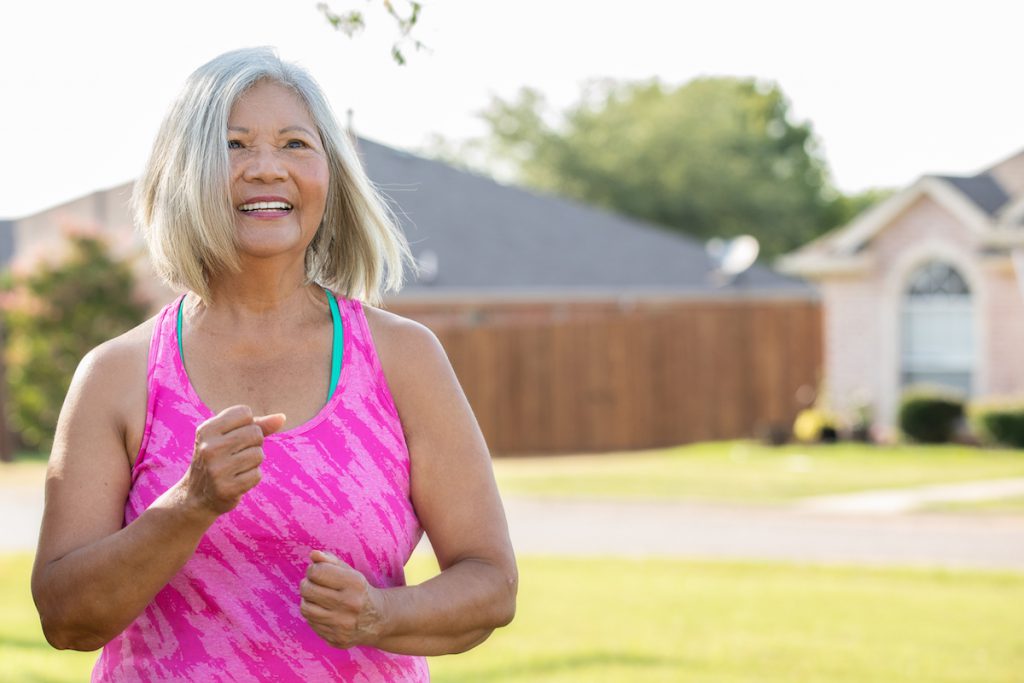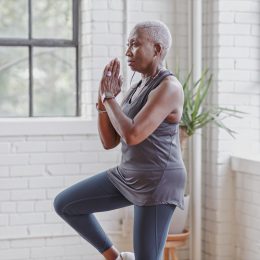Yes, Your Daily Walk Can Help You Lose Weight! Here’s How.
It’s hard to believe something as simple as walking can help you lose weight. But these tips can turn your daily walk turn into a serious calorie-burner.

Walking isn’t an obvious weight loss contender. But when approached correctly, this basic, everyday movement can help budge the scale.
Going for daily walks is a great way to boost your overall health. Walking can even put you in a better mood. When it comes to weight loss, though, it’s all about how you’re walking. If your walk is more of a leisurely stroll, it isn’t likely to help you shave off pounds as easily.
With some simple tweaks, though, you can transform your daily walk into a weight loss tool. Here’s how. (Remember to get your doctor’s OK before beginning any new exercise program.)
Get and stay fit with SilverSneakers! Classes and events are happening right now at participating gyms, online through SilverSneakers LIVE, and at community centers near you. Activate your free online account to get started.
Tip #1: Pick Up the Pace
Walking faster is a surefire way to burn more calories. A 155-pound person burns roughly 133 calories walking for 30 minutes at a pace of 3.5 miles per hour (mph), or 17 minutes per mile. Bumping up the pace to 4 mph (15 minutes per mile) takes the calorie burn to 175, per estimates from Harvard Health.
To find the right pace for you, aim to walk at a speed that allows you to speak only in broken sentences.
“You can keep a conversation going, but it’s more of a huff and puff,” says Robert Linkul, CSCS, a personal trainer who specializes in working with older adults. “As you get fitter, you’ll be able to carry on conversations at a higher intensity,” he adds.
Depending on your fitness level, you may need to switch between bouts of faster and slower walking — and that’s OK. Pay attention to your body and back off if you’re struggling to maintain your pace.
If you’re worried about keeping your balance at a faster pace, invest in a pair of hiking sticks. Walking with hiking sticks (also called Nordic walking) not only offers peace of mind, but it recruits your arm muscles.
“You have to push off with your arms, so you’re actually working harder with hiking sticks than without,” says Linkul. Learn more about Nordic walking, plus find expert tips to get started here.
Did you know SilverSneakers LIVE has an indoor walking class? Walk Strong (Express) is a low-impact workout that will boost your mood and endurance in just 15 minutes! View the schedule and RSVP here.
Tip #2: Go Longer
If you’re not ready to walk faster, walk further. The more steps you get in, the better.
Just be sure to increase your walking distance or duration gradually, as drastic changes can cause injury, cautions the National Institute on Aging.
If you’re just starting a walking routine, Linkul suggests doing 20 minutes twice per week for at least a month. From there, add a third day and go up to 30 minutes.
“By the third month, walk four times a week for 30 minutes or more and continue to build from there,” says Linkul.
Recommended reading: 9 Ways to Kick Up Your Walking Workout
Tip #3: Fuel Right
Walking for weight loss takes more than bumping up intensity, time, or distance. It also requires keeping an eye on the foods you eat. Your body needs healthy foods to power through a walk.
Plus, many people struggle to meet their nutritional needs as they age — our bodies simply can’t absorb or metabolize nutrients as efficiently. If you ignore your diet, there’s a good chance your body is missing out on the nutrients it needs to walk for weight loss, says Angel Planells, R.D.N., a spokesperson for the Academy of Nutrition and Dietetics.
To boost your walking performance, begin by making small improvements to your diet. Be sure to:
- Eat more fruits and vegetables
- Reach for whole grain foods like whole wheat bread instead of refined grains
- Prioritize protein in every meal
- Aim for variety in your diet — this ensures you get enough vitamins and minerals
- Cook at home as often as possible, as restaurant foods tend to be higher in sodium and harmful fats
Tip #4: Stay Motivated
It’s normal for motivation to dip after settling into a walking routine. Finding ways to stay motivated can help you stick with your plan.
Here are a few ideas:
- Walk with a friend or family member (including four-legged ones!)
- Keep track of your progress — seeing improvements can motivate you to continue walking
- Reward yourself when you reach a goal by going to the movies, visiting a museum, or splurging on a massage
- Explore new walking trails in your area
Recommended reading: How to Stay Committed to Your Walking Goals
Tip #5: Talk to Your Health Care Team
According to the Physical Activity Guidelines for Americans, you should aim for at least 150 minutes (2½ hours) of moderate-intensity aerobic exercise, like walking, every week.
But if you’re just starting to add walking to your routine, it’s a good idea to connect with your healthcare provider. This is especially true if you have ongoing health conditions such as arthritis, diabetes, heart disease, or osteoporosis.
Subscribe to our newsletter
It's quick and easy. You could be one of the 13 million people who are eligible.
Already a member? Click to discover our 15,000+ participating locations.
Follow Us
Ask your doctor how your health condition affects your ability to walk for exercise. Your doctor can also help you create a plan to safely increase the intensity or duration of your walks for weight loss.
Be sure to tell your doctor about any symptoms you’ve been experiencing, such as chest pain, dizziness, joint pain, or shortness of breath. Your doctor may recommend addressing those symptoms before you begin a walking program.
Recommended reading: Weight Loss Basics for Older Adults
Fine-Tune Your Walking Form
7-Day Power Your Walk Challenge
See our sources:
How older adults can start exercising: National Institute on Aging
Exercise motivation tips for older adults: National Institute on Aging
How many calories you burn while walking: Harvard Health Publishing
Physical activity guidelines for Americans: U.S. Department of Health and Human Services
Check Your SilverSneakers Eligibility Instantly
SilverSneakers members can go to thousands of gyms and fitness locations across the nation, plus take SilverSneakers LIVE online classes that are designed for seniors of all levels. If you have a Medicare plan, it may include SilverSneakers—at no additional cost. Check your eligibility instantly here.
Already a member? Get your SilverSneakers member ID and exclusive fitness content by activating your online account here.
Not eligible for SilverSneakers? You can still get 200+ free SilverSneakers On-Demand videos and stay in touch with us by creating your online account.




